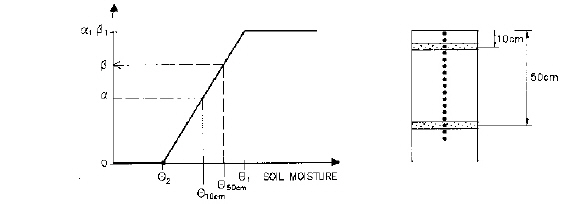 , is calculated as
, is calculated as
Simplified Macropore Flow (bypass flow)
Flow through macropores in unsaturated soil is important for many soil types. In the Unsaturated Zone module, a simple empirical function is used to describe this process. The infiltration water is divided into one part that flows through the soil matrix and another part, which is routed directly to the groundwater table (bypass flow).
The bypass flow is calculated as a fraction of the net rainfall for each UZ time step. The actual bypass fraction is a function of a user-specified maximum fraction and the actual water content of the unsaturated zone, assuming that macropore flow occurs primarily in wet conditions.
Thus, the bypass flow,  , is calculated as
, is calculated as
(28.29) 
where Pnet is the net rainfall rate, and Pfrac is the maximum fraction of the net rainfall which can bypass the matrix (under wet conditions). a10 and b50 are used to reduce the total bypass fraction under dry conditions.
a10 and b50 are calculated internally by MIKE SHE and depend on the actual water contents of the unsaturated zone 10cm and 50cm below the ground surface, respectively. The relationship used to calculate a10 and b50 is illustrated in Figure 28.3. a10 and b50 vary linearly between 0.0 and 1.0 when the water content is between q2 and q1. If the water content is below q2, a10 and b50 equal 0.0. If the water content is above q1, a10 and b50 equal 1.0.
Typically, macropore flow is highest in wet conditions when water is flowing freely in the soil (e.g. moisture content above the field capacity, qFC) and zero when the soil is very dry (e.g. moisture content at the wilting point, qWP)

Figure 28.3 a and b as a function of the soil moisture content 10 cm and 50 cm below the ground surface, respectively.